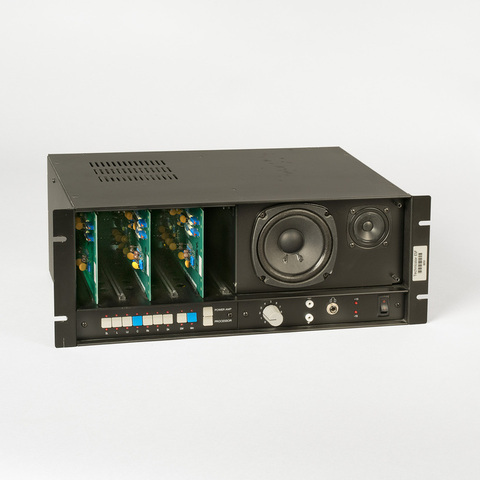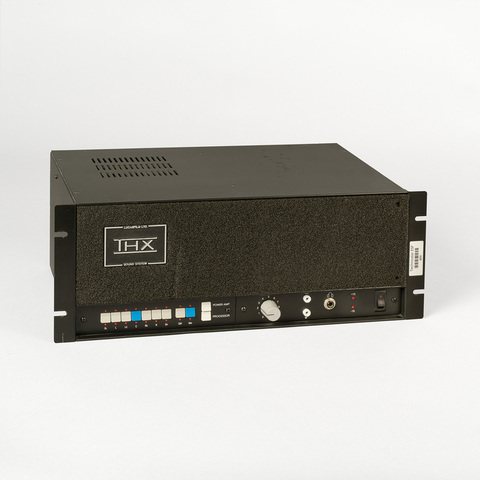Processeur son
Fiche détaillée
Type de l'appareil
rack de processeur son équipé de cartes THX ; deux haut-parleurs ; amplificateur incorporé ; contrôle de volume ; prise casque ; indicateurs LED
Auteurs
Tomlinson Holman
Lucas George
San Francisco, California
Fabricants
Component Engineering Company
Seattle, Washington
Utilisateurs
Tomlinson Holman
Lucas George
San Francisco, California
Distributeurs
Lucasfilm LTD
San Rafael, California
Sujet du modèle
Informations non disponibles
Objectif
Informations non disponibles
Taille de l'objet
Ouvert :
Informations non disponibles
Fermé :
Longueur : 30 cm
Largeur : 48.5 cm
Hauteur : 18 cm
Diamètre :
Informations non disponibles
Taille de la boîte de transport
Informations non disponibles
Remarques
Marques : "Lucasfilm LTD. THX Sound System" ; "1987 Lucasfilm LTD. All rights reserved. Design : exclusive property of Lucasfilm LTD. Manufactured for Lucasfilm LTD. by Component Engineering Co., Seattle, Washington" ; "Component engineering Ltd Model 3417 THX Monitor Serial n° 003596".
La procédé THX est développé en 1982 durant la production de Return of the Jedi. Le nom THX Ltd (division créée en 1983 de Lucasfilm LTD) évoque à la fois le premier film de George Lucas, THX 1138, et de l'ingénieur de son concepteur et développeur, Thomlinson Holman (le "X" faisant référence à eXperiment).
"The THX Sound System for the theatre, was developed in 1982 during the production of Return of the Jedi. Inspired by George Lucas' interest in upgrading film presentation standards in the industry, Lucasfilm's Corporate Technical Director, Tomlison Holman, began to identify problems related to theatre sound. Homan noted theatre audiences were not hearing what was recorded in the film studio - many of the subtle sounds were missing. His innovative approach was to consolidate existing performance standards into a new system which included theatre acoustics as well as sound equipment. Referred to as the Tomlinson Holman eXperiment, THX (also named after Lucas' first feature film, THX 1138) is a sound system designed specifically to reproduce film sound exactly as it was recorded by the filmmaker. The THX Program is the only system of its kind to consider all aspects of a theatre's audio performance, including architecture, acoustics and equipment. "THX is really a performance criteria ; it's not a specific set of components", says Holman. The system was created to complement advances made by Dolby Laboratories in decoding sounds in the sound track which concentrates on the "A" chain. The THX Sound System concentrates on the "B" chain of a theatre's sound system. The "B" chain is comprised of customized acoustical design work for each auditorium, a special screen speaker installation method, a proprietary electronic crossover network, and rigorous audio equipment specifications and performance standards. Upon completion of a THX Sound System installation, the theatre is tested by a trained engineer to make sure it meets both THX technical criteria and recommended industry standards for high quality sound presentation. Theatres are re-tested every year to ensure that optimum quality is maintained. There are now more than 600 certified THX theatres worldwide. A certified THX theatre carries several important advantages for the movie goer. The audience enjoys a more naturally balanced sound that uniformly reaches every seat in the auditorium, improved dialog intelligibility and decreased bass distorsion. Better stereo localization makes the sound appear to travel accross the screen with the action. A frequency range that is wider by a full octave in both bass and treble allows patrons to hear higher highs and lower lows. The combined result is the reproduction of the same clear, dynamic sound originally created by the filmmaker. The exhibitor's challenge is to create an environment that keeps the magic of the big screen alive. The competition that began with the theatre down the street, and extended to the home, has now expanded to include the future. THX is a registered trademark of LucasArts Entertainment Company" (THX Sound System, Simply the Best Sound Around, THX, San Rafael, Lucasfilm, s.d.)
"A modern motion picture theatre audio system is generally characterized as two sub-systems, the "A" chain, and "B" chain. The "A" chain consists of the optical, magnetic, and non sync signal sources and their channel processing. The "B" chain consists of the master fader, auditorium equalization, power amplification, speaker systems, and auditorium environment. Utilizing years of experience, and research in theatre sound, Lucasfilm Ltd. has designed many practical and innovative features into Monitor 3417. The monitor houses and powers up to six THX Sound System crossover cards, and provides switching capability allowing selection of any channels ouput from the processor or power amplifier output through the internal high quality speaker system. Installation of the monitor is made quick and easy by the terminal connection system on the rear panel. This connection design insures an installation free from the all-to-common ground loops found in theatre sound systems. A shielded cable with a D 25 connector is also provided to connect the cinema processors output to the monitor input. The THX Sound System imposes a high frequency boost to overcome screen loss, equalize the constant directivity horn system, and meet the standard "House Curve" as described in ISO 2969 curve X. Unlike other monitors, the 3417's internal power amplifier has a tailored frequency response to compensate for this high frequency boost enabling the operator to monitor a natural sound signal" (THX Monitor 3417, Instruction Manual, San Rafael, Lucasfilm, 1987).
"La carrière de Tom Holman commence dans les années 1980 quand il devient le directeur technique et bras droit de George Lucas pour la conception de Skywalker Ranch au Marin County, Californie. [...] George Lucas se trouvait dans un cinéma afin de se rendre compte personnellement de la perception de ses films dans les salles et il fût épouvanté par la qualité ou le manque de qualité du son. L'idée de développer une série de recommandations concernant les techniques de construction, prenant pour référence l'installation qui se trouvait dans la salle de projection chez Skylwalker - le "Stag Theatre" - se mit à germer et le programme THX était né. [...] Les développements se succédèrent et l'on vit un jour arriver le système THX Junior qui était destiné aux studios de post-production pour TV, ainsi que pour les petits auditoriums et salles de projection. La première version passait par Apogee Sound sous la forme du MPTS-1 [...]. Le corollaire de ce mouvement bascula vers la maison et le programme Home THX fit son apparition avec les innovations telles que le "Bass Management" et les haut-parleurs surrounds di-pôle. Tom Holman a ensuite fondé le TMH Corporation, qui propose une palette de services de consultation pour les systèmes et les installations" (Realisa Son, octobre 2001, p. 10-11).
Bibliographie
THX Sound System, Simply the Best Sound Around, THX, San Rafael, Lucasfilm, s.d.
THX Monitor 3417, Instruction Manual, San Rafael, Lucasfilm, 1987.

